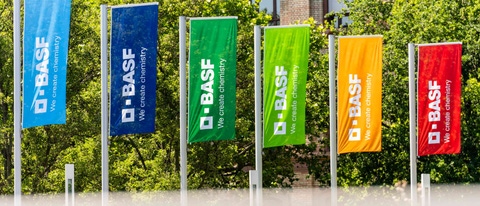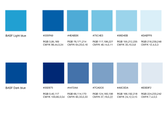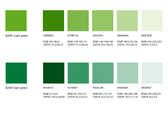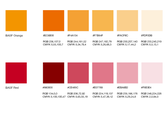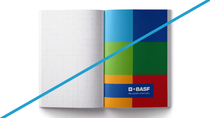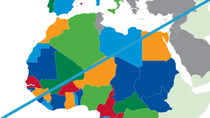Corporate Colors

Usage

Note:
In all communication materials, one of the corporate colors is to be used as the prominent color.
All other corporate colors can be used as supporting colors, e.g. for bullet points, separating lines etc. Please always ensure that the overall effect of the media is homogeneous and does not appear randomly colorful.
The corporate colors are used only in media, in market and corporate communication material. In applications that fulfill a purely functional or informational purpose and do not serve in market and corporate communications, we have consciously chosen not to use a color (e.g. internal signage or building signs).
Color definition
Brilliant colors in all media
In order to ensure a uniform appearance of all colors in all media, we have defined the color values for various color systems.
We recommend four-color printing (CMYK) for printing on paper. Printing with a spot color (e. g. one spot color and black) should only be done when four-color printing is not cost-effective.
Four-color printing (CMYK) is the reference color system for establishing the BASF corporate colors. The most similar colors possible for other color systems have been determined. Due to the limited selection in other color systems, these colors will never match the original CMYK colors perfectly.
Note:
The defined color value of the respective corporate color is used for the logo bar.
For printing on paper, we reommend to use the four-color printing (CMYK). On digital touchpoints, RGB and Hexadecimal are the prefered color systems. Read more about the different color systems below on this page.
The definition of the corporate colors is based on CMYK as most communication materials are produced in four-colour printing.
Other color systems merely allow approximations of these colors.
* Slight difference from CMYK color.
** Some difference from CMYK color.
*** Significant difference from CMYK color.
Brand colors

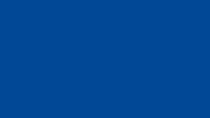
| BASF light blue | |
| CMYK coated, uncoated | 87/24/0/0 |
| sRGB decimal | 33/160/210 |
| Hexadecimal | #21A0D2 |
|
PANTONE coated PANTONE uncoated |
2925 C * 2995 U * |
| RAL | RAL 5012 Light blue |
|
HKS 3000 coated HKS 3000 uncoated |
47 K-70-30 ** 47 N-90-0 * |
| NCS | S 1560-R90B |
| BASF dark blue | |
| CMYK coated, uncoated | 100/75/0/5 |
| sRGB dezimal | 0/74/150 |
| Hexadezimal | #004A96 |
|
PANTONE coated PANTONE uncoated |
Reflex Blue C *** Reflex Blue U *** |
| RAL | RAL 5002 Ultramarine blue |
|
HKS 3000 coated HKS 3000 uncoated |
42 K-80-30 * 42 N-100-10 * |
| NCS | S 4055-R70B |

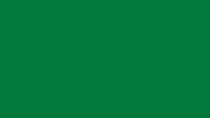
| BASF light green | |
| CMYK coated, uncoated | 70/0/100/5 |
| sRGB decimal | 101/172/30 |
| Hexadecimal | #65AC1E |
|
PANTONE coated PANTONE uncoated |
369 C ** 376 U *** |
| RAL | RAL 6018 Yellow green |
|
HKS 3000 coated HKS 3000 uncoated |
67 K-100-30 * 67 N-100-1 * |
| NCS | S 2075-G30Y |
| BASF dark green | |
| CMYK coated, uncoated | 100/0/91/28 |
| sRGB decimal | 0/121/58 |
| Hexadecimal | #00793A |
|
PANTONE coated PANTONE uncoated |
356 C * 355 U ** |
| RAL | RAL 6032 Signal green |
|
HKS 3000 coated HKS 3000 uncoated |
57 K-90-30 * 57 N-90-10 * |
| NCS | S 3065-G10Y |

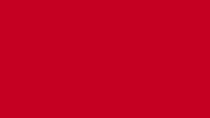
| BASF orange | |
| CMYK coated, uncoated | 0/47/100/0 |
| sRGB decimal | 243/149/0 |
| Hexadecimal | #F39500 |
|
PANTONE coated PANTONE uncoated |
144 C ** 144 U ** |
| RAL | RAL 1007 Daffodil yellow |
|
HKS 3000 coated HKS 3000 uncoated |
6 K-80-10 *** 6 N-80-10 *** |
| NCS | S 1080-Y30R |
| BASF red | |
| CMYK coated, uncoated | 0/100/80/20 |
| sRGB decimal | 197/0/34 |
| Hexadecimal | #C50022 |
|
PANTONE coated PANTONE uncoated |
187 C ** 1797 U *** |
| RAL | RAL 3031 Orient red |
|
HKS 3000 coated HKS 3000 uncoated |
15 K-100-10 * 15 N-100-10 * |
| NCS | S 1580-Y90R |
Color Shades
Below, you'll find the codes for the most commonly used color shades of each of our 6 corporate colors. These shades are suggested to facilitate your choice of corporate color shades while creating communication materials. However, they are not mandatory. You can use any shade of each corporate color, as long as the differences between the gradations are clearly visible (no gradient).
Skin and Hair Colors

The picture shows only some possible color combinations. All skin and hair colors can be combined with each other as desired.
Skin Tones

#602406
RGB 96/36/6
CMYK 38/84/96/58

#C05739
RGB 192/87/57
CMYK 19/74/79/8

#A9673A
RGB 196/103/58
CMYK 26/60/79/19

#FCBF92
RGB 252/191/146
CMYK 0/32/45/0
Hair Colors

#EDAB18
RGB 237/171/24
CMYK 6/36/94/0

#A9673A
RGB 196/103/58
CMYK 26/60/79/19

#A3A3A3
RGB 163/163/163
CMYK 38/29/30/8

#3F3F3F
RGB 63/63/63
CMYK 66/56/53/58

#602406
RGB 96/36/6
CMYK 38/84/96/58

#C05739
RGB 192/87/57
CMYK 19/74/79/8
Don'ts
In general only one prominent corporate color should be used. This means we avoid the random combination of colors in our design.
